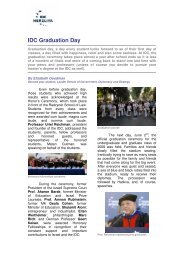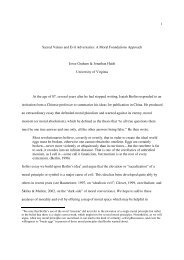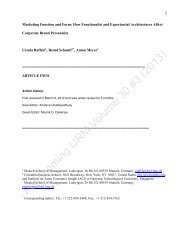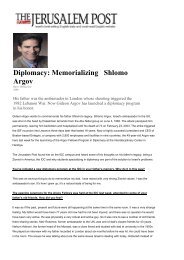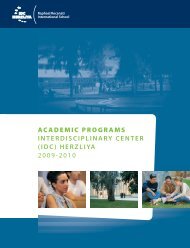Responsiveness: Affective Interdependence in Close Relationships ...
Responsiveness: Affective Interdependence in Close Relationships ...
Responsiveness: Affective Interdependence in Close Relationships ...
Create successful ePaper yourself
Turn your PDF publications into a flip-book with our unique Google optimized e-Paper software.
<strong>Responsiveness</strong>: <strong>Affective</strong> <strong>Interdependence</strong> <strong>in</strong> <strong>Close</strong> <strong>Relationships</strong><br />
Harry T. Reis<br />
The University of Rochester<br />
What makes the behavior of two partners <strong>in</strong> a close relationship different from the<br />
behavior of two <strong>in</strong>dependent <strong>in</strong>dividuals? The answer to this question, which is fundamental to<br />
relationship science, usually <strong>in</strong>volves some sort of mutual <strong>in</strong>fluence and <strong>in</strong>terdependence. For<br />
example, Kelley (1983) refers to a causal connection between two <strong>in</strong>teract<strong>in</strong>g parties, <strong>in</strong> the<br />
sense that one person's behavior is causally implicated <strong>in</strong> subsequent changes <strong>in</strong> the other person.<br />
Follow<strong>in</strong>g this def<strong>in</strong>ition, <strong>in</strong>terdependence theorists describe <strong>in</strong> precise detail how each partner's<br />
behavior is affected by the implications of the other's behavior for both of their outcomes (see<br />
Rusbult & Van Lange, 1996, for a review). Commonly, studies <strong>in</strong> this area exam<strong>in</strong>e the<br />
implications of different types of <strong>in</strong>terdependence for a variety of relationship-relevant<br />
behaviors.<br />
Sometimes overlooked <strong>in</strong> <strong>in</strong>terdependence theoriz<strong>in</strong>g is affective <strong>in</strong>terdependence – the<br />
extent to which emotions and emotional self-regulation are <strong>in</strong>fluenced by partners. Yet by almost<br />
any def<strong>in</strong>ition affective <strong>in</strong>terdependence is a card<strong>in</strong>al characteristic of close relationships. Thus,<br />
<strong>in</strong> summ<strong>in</strong>g up a series of alternative theoretical positions, Ekman and Davidson succ<strong>in</strong>ctly noted<br />
that "emotions are brought <strong>in</strong>to play most often by the actions of others, and, once aroused,<br />
emotions <strong>in</strong>fluence the course of <strong>in</strong>terpersonal transactions" (1994, p. 139). Reis, Coll<strong>in</strong>s, and
Berscheid (2000) qualified this conclusion by not<strong>in</strong>g that the others who create these actions and<br />
engage <strong>in</strong> these transactions are usually relationship partners.<br />
Consider these examples of affective <strong>in</strong>terdependence <strong>in</strong> close relationships. A husband<br />
responds angrily when his wife, hav<strong>in</strong>g had a stressful day at work, barks at him because the<br />
house is a mess when she returns home after work. Two parents feel great pride when their child<br />
sets a school record <strong>in</strong> a swimm<strong>in</strong>g event. A young woman asks a friend to listen to her describe<br />
her feel<strong>in</strong>gs about hav<strong>in</strong>g been dumped by her boyfriend. Two lovers flirt, each tak<strong>in</strong>g pleasure<br />
<strong>in</strong> its impact on the other. An elderly married couple rem<strong>in</strong>isces about life experiences they have<br />
shared. A young couple discusses plans for the future, each of them discouraged by the other's<br />
lack of <strong>in</strong>terest <strong>in</strong> his/her most highly valued goals.<br />
What these illustrations have <strong>in</strong> common is the idea that each person's affective<br />
experience is centrally and substantially <strong>in</strong>fluenced by the other's behavior. Although a variety of<br />
different theoretical models have been proposed to expla<strong>in</strong> these seem<strong>in</strong>gly dist<strong>in</strong>ct phenomena,<br />
<strong>in</strong> this chapter, I propose that a common conceptual core l<strong>in</strong>ks them. I call this core process<br />
perceived partner responsiveness. The first section of this chapter def<strong>in</strong>es perceived partner<br />
responsiveness, expla<strong>in</strong><strong>in</strong>g how and why it may serve as a core organiz<strong>in</strong>g pr<strong>in</strong>ciple for<br />
<strong>in</strong>tegrat<strong>in</strong>g social-psychological theories about affective <strong>in</strong>terdependence. In the next section, I<br />
illustrate the operation of perceived partner responsiveness with examples from three research<br />
programs conducted <strong>in</strong> our lab on (1) the role of perceived partner responsiveness <strong>in</strong> self-<br />
regulation; (2) how partners help each other capitalize on personal positive events; and (3) the<br />
role of partners <strong>in</strong> promot<strong>in</strong>g movement toward personal goals. Throughout this review, for<br />
reasons of theoretical clarity, I will focus on perceived partner responsiveness and its association<br />
with personal and relationship well-be<strong>in</strong>g. Nevertheless, because this model considers perceived<br />
1
partner responsiveness to be a product of certa<strong>in</strong> k<strong>in</strong>ds of <strong>in</strong>terpersonal experiences, I also<br />
consider actual (or <strong>in</strong> other words, enacted) partner responsiveness. The chapter concludes with<br />
general comments about the value of <strong>in</strong>tegrative theoretical models for advanc<strong>in</strong>g relationship<br />
science.<br />
A General Model of Perceived Partner <strong>Responsiveness</strong><br />
As noted above, there are many theoretical models <strong>in</strong> close relationship research that help<br />
expla<strong>in</strong> how a partner's behavior <strong>in</strong>fluences one's affect. Consider a few selective examples:<br />
attachment theory (Mikul<strong>in</strong>cer & Shaver, 2007); social support (reviewed by Cohen,<br />
Underwood, & Gottlieb, 2000); the <strong>in</strong>timacy process model (Reis & Shaver, 1988); the need to<br />
belong (Baumeister & Leary, 1995); communal need satisfaction (Clark & Mills, 1993); the risk<br />
regulation model (Murray, Holmes, & Coll<strong>in</strong>s, 2006); trust (Simpson, 2007); partner affirmation,<br />
also known as the Michelangelo Phenomenon (Rusbult, F<strong>in</strong>kel, & Kumashiro, 2009); autonomy<br />
support (Deci & Ryan, 1987); the TIES (temporal <strong>in</strong>terpersonal emotion systems) model (Butler,<br />
2011); and emotional acceptance (Jacobson & Christensen, 1998).<br />
Embedded with<strong>in</strong> each of these specific theories is the general idea that when partners are<br />
felt to be respond<strong>in</strong>g supportively to important needs, goals, values, or preferences <strong>in</strong> the self-<br />
concept, emotional well-be<strong>in</strong>g is enhanced and effective emotional self-regulation is facilitated.<br />
On the other hand, when partners are seen to be respond<strong>in</strong>g critically or when their response is<br />
perceived to be controll<strong>in</strong>g or acont<strong>in</strong>gent, emotional well-be<strong>in</strong>g suffers and emotional self-<br />
regulation is impaired. We refer to this phenomenon as perceived partner responsiveness.<br />
As Figure 1 shows, perceived partner responsiveness is shaped by both <strong>in</strong>trapersonal and<br />
<strong>in</strong>terpersonal forces. The process beg<strong>in</strong>s <strong>in</strong>trapersonally, with the person's own needs, goals, and<br />
wishes, such as when one partner expresses a need, preference, or aspiration, relates an event for<br />
2
which support or celebration is desired, or otherwise reveals important aspects of the self. (Of<br />
course these <strong>in</strong>trapersonal factors are often shaped by past relationship experiences; Chen,<br />
Boucher, & Tapias, 2006; Mikul<strong>in</strong>cer & Shaver, 2007.) The <strong>in</strong>terpersonal step follows, when the<br />
partner enacts a supportive response, which may lead to the perception of responsiveness by the<br />
orig<strong>in</strong>ator. Responses are likely to be perceived as responsive to the extent that they possess<br />
three qualities: (a) Understand<strong>in</strong>g, or whether the partner is believed to have accurately and<br />
appropriately "got the facts right" about oneself. Understand<strong>in</strong>g matters because it fosters a sense<br />
of authenticity (Kernis & Goldman, 2006) and also because the next two factors are predicated<br />
on it. (b) Validation, or the belief that partners value and appreciate one's abilities, traits, and<br />
world view. Validation matters because it conveys the partner's lik<strong>in</strong>g for and acceptance of the<br />
self (F<strong>in</strong>kenauer & Righetti, <strong>in</strong> press), which supports belong<strong>in</strong>gness and felt security (Leary &<br />
Guagadno, 2008; Murray et al., 2006). (c) Car<strong>in</strong>g, or the confidence that partners will provide<br />
help when it is needed, which demonstrates their concern for one's well-be<strong>in</strong>g (Clark & Mills,<br />
2012).<br />
Of course, the process may not unfold as straight-forwardly as Figure 1 implies. One<br />
partner might reveal needs but the other partner might not respond supportively. More po<strong>in</strong>tedly,<br />
even if the respond<strong>in</strong>g partner behaves supportively, as an <strong>in</strong>dependent observer might verify,<br />
the disclos<strong>in</strong>g partner might misperceive this responsiveness, reflect<strong>in</strong>g the impact of motivated<br />
biases on social perception. As I will argue later <strong>in</strong> this chapter, there is good reason to believe<br />
that both actual responsiveness and motivated <strong>in</strong>terpretation <strong>in</strong>fluence perceived partner<br />
responsiveness (Reis & Clark, <strong>in</strong> press). However, from a theoretical standpo<strong>in</strong>t, emotional<br />
responses to the sorts of sequences depicted <strong>in</strong> Figure 1 are based on what is perceived, rather<br />
than what is enacted. In other words, the emotions that result from the unfold<strong>in</strong>g of the<br />
3
disclosure-and-response process depend on whether the perceiver believes that the response has<br />
been understand<strong>in</strong>g, validat<strong>in</strong>g, and car<strong>in</strong>g, or mis<strong>in</strong>formed, nonappreciative, and uncar<strong>in</strong>g.<br />
In a relationship, this sequence necessarily <strong>in</strong>fluences both partners' affects, but I have<br />
omitted those l<strong>in</strong>ks for simplicity. It nevertheless should be acknowledged that successfully<br />
provid<strong>in</strong>g responsiveness is likely to foster positive emotions <strong>in</strong> its own right, and will encourage<br />
partners to <strong>in</strong>itiate these sequences on their own. Similarly, there is ample evidence that<br />
recipients of responsiveness are likely to be responsive when revers<strong>in</strong>g roles with their<br />
supporters. The converse is also true: failed or <strong>in</strong>adequate attempts to elicit or provide<br />
responsiveness are likely to foster negative emotions and to discourage role-reversal <strong>in</strong><br />
subsequent <strong>in</strong>teractions.<br />
Perceived Partner <strong>Responsiveness</strong> and Self-Regulation<br />
Self-regulation refers to people's attempts to modify or control their own thoughts,<br />
feel<strong>in</strong>gs, and behavior <strong>in</strong> order to achieve desired outcomes or to make progress toward valued<br />
goals. Of the many factors that affect self-regulation, some of the most <strong>in</strong>fluential concern<br />
feedback and support from significant others. Theoretically, the self-regulatory value of support<br />
can be traced to the <strong>in</strong>tr<strong>in</strong>sically social nature of our species. The human bra<strong>in</strong> evolved to<br />
facilitate bond<strong>in</strong>g as a central means for address<strong>in</strong>g adaptive problems associated with survival<br />
and reproduction. Thus, evolutionary forces created various specific mechanisms designed to<br />
help people live and work together, coord<strong>in</strong>at<strong>in</strong>g their activities to accomplish mutually desired<br />
goals. Among these are several familiar mechanisms from the social-psychological literature. For<br />
example, the perceived availability of social support facilitates effective cop<strong>in</strong>g with stress<br />
(Stroebe & Stroebe, 1996). Feel<strong>in</strong>g valued and accepted by others is associated with emotional<br />
well-be<strong>in</strong>g and persistence on various tasks (Leary & Guadagno, 2008). Particularly well-<br />
4
documented is evidence that the actual or symbolic availability of attachment figures engenders<br />
better emotional health, greater compassion and car<strong>in</strong>g for others, and more effective exploration<br />
(Feeney & Thrush, 2010; Mikul<strong>in</strong>cer & Shaver, 2007).<br />
Perceived partner responsiveness is central to all of these mechanisms. Know<strong>in</strong>g that a<br />
partner has one's back – <strong>in</strong> other words, that he or she will be available if needed and is will<strong>in</strong>g to<br />
provide nurturance or assistance, even if it were to be costly – gives people the emotional<br />
wherewithal to deal with challenges and the security to <strong>in</strong>teract with others confidently and non-<br />
defensively. Describ<strong>in</strong>g this general sense <strong>in</strong> terms of perceived partner responsiveness focuses<br />
attention on the three components depicted <strong>in</strong> Figure 1. Thus understand<strong>in</strong>g <strong>in</strong>dicates that the<br />
partner has an accurate view of oneself, of one's needs and fears, of what one <strong>in</strong>tends to make<br />
happen, and of what one is capable of do<strong>in</strong>g. Validation signifies the partner's esteem, imply<strong>in</strong>g<br />
that he or she would sacrifice self-<strong>in</strong>terest for the good of the relationship (Murray & Holmes,<br />
2011). Car<strong>in</strong>g directly implicates the partner's active concern for one's well-be<strong>in</strong>g. All of these<br />
together make the symbolic or actual support of a responsive other credible and trustworthy.<br />
Research conducted <strong>in</strong> our lab over the past decade or so broadly supports this<br />
conclusion. For example, perceived partner responsiveness is associated with better sleep quality<br />
<strong>in</strong> married couples (Carmichael & Reis, 2005) and healthier, more positive attitudes toward sex,<br />
especially among women (Birnbaum & Reis, 2006). Both of these can be considered examples of<br />
effective self-regulation <strong>in</strong> a relationship context, <strong>in</strong>asmuch as anxiety about a partner's<br />
acceptance and support would underm<strong>in</strong>e that activity. In the achievement doma<strong>in</strong>, perceived<br />
partner responsiveness also predicts better engagement and performance. In a series of studies,<br />
Elliot and Reis (2003) showed that college students who felt that attachment figures were<br />
responsive and supportive viewed their college courses as challeng<strong>in</strong>g more than threaten<strong>in</strong>g,<br />
5
and showed higher achievement motivation, lower fear of failure, and more approach-oriented<br />
(as opposed to avoidance-oriented) motives about school work. In an unpublished study, Peter<br />
Caprariello and I found the same pattern with regard to college athletes’ participation <strong>in</strong><br />
competitive athletics.<br />
<strong>Responsiveness</strong> is usually studied <strong>in</strong> the context of <strong>in</strong>timate relationships, but it also<br />
applies <strong>in</strong> less personal relationships. Reis, Clark, Pereira-Gray, Tsai, Brown, Stewart, and<br />
Underwood (2008) surveyed 819 <strong>in</strong>dividuals <strong>in</strong> three countries (the United States, Canada, and<br />
the United K<strong>in</strong>gdom) about the extent to which they felt that their primary care physician was<br />
responsive to their needs and concerns, and was genu<strong>in</strong>ely <strong>in</strong>terested <strong>in</strong> their thoughts and<br />
feel<strong>in</strong>gs. Despite marked differences <strong>in</strong> the patient-physician relationship <strong>in</strong> these very different<br />
health-care systems, perceived physician responsiveness predicted subjective health <strong>in</strong> each<br />
country (even after controll<strong>in</strong>g for gender, age, marital status, years as patient, and general<br />
satisfaction with that physician). This f<strong>in</strong>d<strong>in</strong>g meshes well with research on patient-centered<br />
communication (that is, a communication process between physician and patient that emphasizes<br />
responsiveness, openness, and active participation by the patient <strong>in</strong> all decisions), which<br />
consistently produces higher patient satisfaction (Epste<strong>in</strong> & Street, 2007) and lower costs<br />
(Epste<strong>in</strong> et al., 2005).<br />
The most direct research l<strong>in</strong>k<strong>in</strong>g perceived partner responsiveness to self-regulation is<br />
experimental. Caprariello and Reis (2009) exam<strong>in</strong>ed the possibility that simply th<strong>in</strong>k<strong>in</strong>g about<br />
responsive partners can provide an adaptive resource under threaten<strong>in</strong>g circumstances. One of<br />
their studies exam<strong>in</strong>ed self-handicapp<strong>in</strong>g, a defensive reaction to the prospect of ego-deflat<strong>in</strong>g<br />
failure. Participants <strong>in</strong> this research were led to believe that they would be videotaped <strong>in</strong> a<br />
stressful subtraction race – count<strong>in</strong>g backwards as quickly as possible from 1,978 by a random<br />
6
two-digit number. Beforehand, they were asked to write a brief essay about someone whom they<br />
felt was a responsive partner (def<strong>in</strong>ed as above), or, <strong>in</strong> three different control conditions, a friend<br />
who was not particularly responsive but with whom they had fun, an acqua<strong>in</strong>tance, or an object<br />
that helped organize their daily activities. Participants were then given a checklist of 14 external<br />
circumstances (e.g., “<strong>in</strong>sufficient rest”) that might hamper their performance <strong>in</strong> the subtraction<br />
race, a standard measure of self-handicapp<strong>in</strong>g. The more reasons checked off, the more defensive<br />
the response – that is, the greater the desire to rationalize <strong>in</strong> advance the possibility of poor<br />
performance. As expected, <strong>in</strong> the three control conditions, the more threatened participants felt,<br />
the more they self-handicapped. But <strong>in</strong> the responsiveness-prim<strong>in</strong>g condition, higher perceptions<br />
of threat were associated with lesser self-handicapp<strong>in</strong>g, presumably because these participants<br />
had readily accessible images of a supportive, car<strong>in</strong>g partner.<br />
This experiment, along with others of a similar ve<strong>in</strong> (Kumashiro & Sedikides, 2005;<br />
Mikul<strong>in</strong>cer & Shaver, 2007; Selcuk, Zayas, Günaydýn, Hazan, & Kross, 2012), <strong>in</strong>dicates that<br />
perceived partner responsiveness provides a valuable resource for adaptive self-regulation.<br />
Perceived Partner <strong>Responsiveness</strong> and Capitaliz<strong>in</strong>g on Positive Events<br />
<strong>Responsiveness</strong> is usually studied <strong>in</strong> the context of negative events – for example, how<br />
partners react when one seeks help cop<strong>in</strong>g with a stressful event, how they react to conflict or<br />
requests for change, or when an <strong>in</strong>dividual’s sense of felt security has been threatened.<br />
Undoubtedly, such circumstances are critical for establish<strong>in</strong>g and ma<strong>in</strong>ta<strong>in</strong><strong>in</strong>g responsiveness <strong>in</strong><br />
relationships. Nevertheless, the field’s emphasis on problems, conflicts, and threat may have<br />
obscured the impact of more positive situations. <strong>Relationships</strong>, after all, are not just about fix<strong>in</strong>g<br />
problems and deal<strong>in</strong>g with stress – they are also about shar<strong>in</strong>g joy, jo<strong>in</strong>tly pursu<strong>in</strong>g valued goals,<br />
and promot<strong>in</strong>g growth as an <strong>in</strong>dividual and as a couple.<br />
7
For the past decade or so, we have been explor<strong>in</strong>g a phenomenon we call capitalization<br />
(see Gable & Reis, 2011, for a review). First described by Langston (1994), capitalization <strong>in</strong><br />
<strong>in</strong>terpersonal contexts refers to the process of convey<strong>in</strong>g personal good news to other persons.<br />
Such conversations <strong>in</strong>itiate a process that has both personal and relational implications. Although<br />
on the surface capitalization attempts focus on the transmission of <strong>in</strong>formation to other persons,<br />
the <strong>in</strong>terpersonal substance of these <strong>in</strong>teractions depends on the emotions and sense of<br />
<strong>in</strong>terdependence experienced dur<strong>in</strong>g the exchange (Rimé, 2007). Capitalization attempts do not<br />
guarantee responsiveness, of course; they merely create the possibility of an encourag<strong>in</strong>g partner<br />
response. After all, partners may or may not display awareness of, and a will<strong>in</strong>gness to support,<br />
the other's aspirations and accomplishments. Partners may experience ambivalence, envy, or<br />
<strong>in</strong>difference; the event may amplify conflicts of <strong>in</strong>terest; or it may threaten stable patterns of<br />
<strong>in</strong>teraction (e.g., alter<strong>in</strong>g their relative status or availability). In other words, responsiveness to<br />
capitalization attempts may be diagnostic of a partner's regard for the self, just as it <strong>in</strong> conflictual<br />
<strong>in</strong>teractions.<br />
Capitalization attempts can be considered as stimuli that afford partners the opportunity<br />
to demonstrate responsiveness. Enthusiastic or otherwise supportive responses signal the<br />
listeners' <strong>in</strong>terest <strong>in</strong> the capitalizer's growth and well-be<strong>in</strong>g. Such responsiveness begets<br />
appreciation and car<strong>in</strong>g, and thereby <strong>in</strong>creases the likelihood of reciprocated pro-partner<br />
behavior. Pro-partner behaviors are associated with a variety of affective outcomes, such as<br />
satisfaction and commitment, and behavioral outcomes, such as trust, accommodation, and the<br />
will<strong>in</strong>gness to sacrifice. On the other hand, a partner's non-responsiveness – for example,<br />
emotional disengagement or criticism – implies dis<strong>in</strong>terest <strong>in</strong> one's well-be<strong>in</strong>g and growth and is<br />
8
likely to create distance and mutual cyclical deterioration (a mutually self-perpetuat<strong>in</strong>g<br />
reluctance to enact pro-relational behaviors with the partner).<br />
In several studies and experiments, we have shown that responsiveness has clear personal<br />
benefit for capitalizers: it enhances the memorability, perceived significance, and emotional<br />
appreciation of positive events. In this chapter I want to focus on the <strong>in</strong>terpersonal benefits of<br />
perceived partner responsiveness to capitalization attempts.<br />
Our earliest studies exam<strong>in</strong>ed perceptions of how partners generally respond to be<strong>in</strong>g told<br />
about one's good news, us<strong>in</strong>g the Perceived Responses to Capitalization Attempts (PRCA) scale<br />
(Gable, Reis, Impett, & Asher, 2004). In several college student and middle-aged community<br />
samples, the perception of enthusiastic, engaged responses was associated with higher<br />
relationship satisfaction, <strong>in</strong>timacy, and, <strong>in</strong> a daily diary study, more frequent positive<br />
<strong>in</strong>teractions. In contrast, the perception of passive or destructive responses was associated with<br />
lower satisfaction and <strong>in</strong>timacy and fewer positive <strong>in</strong>teractions (Gable et al., 2004; Reis et al.,<br />
2010). These f<strong>in</strong>d<strong>in</strong>gs are unlikely to be entirely due to motivated perception or response bias. In<br />
several laboratory-observation studies, Gable and her colleagues have shown that cod<strong>in</strong>g by<br />
<strong>in</strong>dependent observers of partner responsiveness to capitalization attempts predicted relationship<br />
well-be<strong>in</strong>g and stability at later times (Gable, Gonzaga, & Strachman, 2006; Gable, Gosnell,<br />
Maisel, & Strachman, 2012). Also, <strong>in</strong> another set of studies from our lab, Shannon Smith has<br />
shown that responders to capitalization attempts show similar benefits to capitalizers.<br />
<strong>Affective</strong> <strong>in</strong>terdependence implies someth<strong>in</strong>g more than good feel<strong>in</strong>gs, however. Our<br />
model of capitalization and responsiveness suggests that supportive responses should lead to the<br />
<strong>in</strong>ference that partners have one's best <strong>in</strong>terest at heart, an attribution that is central to trust. Reis<br />
et al. (2010) tested this idea experimentally. In a capitalization condition, participants described<br />
9
to an <strong>in</strong>terviewer one of the best events to have happened to them <strong>in</strong> the past few years. The<br />
<strong>in</strong>terviewer was tra<strong>in</strong>ed to respond with <strong>in</strong>terest and enthusiasm (e.g., "wow, that's really great"<br />
and "what a great opportunity"). In one control condition, the <strong>in</strong>terviewer simply took notes,<br />
offer<strong>in</strong>g m<strong>in</strong>imal commentary. In another control condition, participants described a series of Dr.<br />
Seuss pictures that the <strong>in</strong>terviewer had to draw (without see<strong>in</strong>g the picture directly), a highly<br />
enjoyable, engag<strong>in</strong>g activity (Fraley & Aron, 2004). Both mood and lik<strong>in</strong>g for the <strong>in</strong>terviewer<br />
were significantly higher <strong>in</strong> the capitalization and fun conditions than <strong>in</strong> the notes condition.<br />
More importantly, trust, responsiveness, and the will<strong>in</strong>gness to disclose sensitive personal<br />
<strong>in</strong>formation were significantly higher <strong>in</strong> the capitalization condition than <strong>in</strong> either of the other<br />
two conditions. In short, responsive listen<strong>in</strong>g builds trust and <strong>in</strong>timacy, not just lik<strong>in</strong>g.<br />
We obta<strong>in</strong>ed conceptually similar results <strong>in</strong> a daily diary study. Participants <strong>in</strong> this<br />
research nom<strong>in</strong>ated a target person – someone to whom they were close and likely to <strong>in</strong>teract<br />
with every day of the 14-day diary period. Each day, <strong>in</strong> addition to describ<strong>in</strong>g the best th<strong>in</strong>g to<br />
have happened on that day, participants also reported whether they had <strong>in</strong>formed their target<br />
person about those events and, if they had, how the target had responded. Elsewhere <strong>in</strong> the diary,<br />
they described their relationship with the target on that day along several dimensions that<br />
<strong>in</strong>dicate the will<strong>in</strong>gness to enact pro-relationship transformations – specifically, how nice,<br />
accommodat<strong>in</strong>g, and will<strong>in</strong>g to sacrifice they had been toward the target – key markers of<br />
constructive <strong>in</strong>terdependence (e.g., Rusbult, Verette, Whitney, Slovik, & Lipkus, 1991). As<br />
expected, perceiv<strong>in</strong>g the partner's response to one's good news as enthusiastic led to significantly<br />
more favorable pro-relationship orientations. Because these analyses control for the prior-day's<br />
orientation, they show how relationships change from one day to the next, rather than describ<strong>in</strong>g<br />
stable attributes of <strong>in</strong>dividuals or relationships.<br />
10
One f<strong>in</strong>al po<strong>in</strong>t <strong>in</strong> this section. Shar<strong>in</strong>g affect about personal positive events is one way<br />
that partners can promote positive <strong>in</strong>terdependence <strong>in</strong> their relationship – <strong>in</strong> other words, by<br />
"<strong>in</strong>clud<strong>in</strong>g the other <strong>in</strong> the self," each may share to some extent <strong>in</strong> the other's positive<br />
experiences. Such shar<strong>in</strong>g may be particularly valuable <strong>in</strong> help<strong>in</strong>g to repair the damage done by<br />
annoyances, conflicts, and other threats to relationship security. We reasoned that self-esteem<br />
might moderate people's ability to take advantage of this tactic. Prior research has shown that<br />
people with low self-esteem react to relationship threats by distanc<strong>in</strong>g themselves from their<br />
partners, whereas people with high esteem attempt to move closer. Consistent with this logic,<br />
after prim<strong>in</strong>g with relationship threat (<strong>in</strong> a field experiment) or on days follow<strong>in</strong>g relationship<br />
conflict (<strong>in</strong> a daily diary study), low self-esteem persons perceived less partner enthusiasm about<br />
a personal positive event, but high self-esteem persons perceived more partner enthusiasm. (Self-<br />
esteem had no impact after a neutral prime or no-conflict days.) In other words, the effectiveness<br />
of perceived responsiveness to capitalization attempts as a strategy for repair<strong>in</strong>g relationships<br />
follow<strong>in</strong>g threat appears to depend on self-esteem.<br />
<strong>Responsiveness</strong> and <strong>Interdependence</strong>: Mutual Cyclical Growth<br />
Up to this po<strong>in</strong>t, I have focused on perceived partner responsiveness. The model depicted<br />
<strong>in</strong> Figure 1 is actually somewhat more <strong>in</strong>terpersonal than this, propos<strong>in</strong>g that the sequence beg<strong>in</strong>s<br />
when one party expresses a need or desire <strong>in</strong> which the other might be helpful and cont<strong>in</strong>ues only<br />
when the other party enacts a supportive response. Partners do not always react supportively, of<br />
course, and supportive responses are sometimes misperceived. However, for this model to be<br />
truly <strong>in</strong>terpersonal and <strong>in</strong>teractional, it must consider how real partner behaviors contribute to<br />
perceived partner responsiveness.<br />
Why should actual <strong>in</strong>teractions matter? Perceived partner responsiveness is to some<br />
11
extent an attribution, as Kelley (1979) first suggested: When one partner demonstrates a<br />
will<strong>in</strong>gness to set aside his or her own preferences and <strong>in</strong>stead prioritize the other's needs and<br />
<strong>in</strong>terests, an observer is led to the logical <strong>in</strong>ference of car<strong>in</strong>g and concern, the fundamental<br />
property of a communal relationship (Clark & Mills, 1993). These <strong>in</strong>ferences must have some<br />
basis <strong>in</strong> fact. If motivated perception were fundamentally out of touch with social reality, it<br />
would not well serve people's basic goals and motivational purposes. This is what Bowlby<br />
(1973) meant when he observed that "the varied expectations of the accessibility and<br />
responsiveness of attachment figures that different <strong>in</strong>dividuals develop dur<strong>in</strong>g the years of<br />
immaturity are tolerably accurate reflections of the experiences those <strong>in</strong>dividuals have actually<br />
had" (p, 202). Consistent with his proposal, many studies show that perceptions of<br />
responsiveness and support tend to be grounded <strong>in</strong> partners' actual behavior (see Reis & Clark, <strong>in</strong><br />
press, for a summary).<br />
Acknowledg<strong>in</strong>g the <strong>in</strong>teractional ground<strong>in</strong>g of perceived partner responsiveness may help<br />
appreciate its role <strong>in</strong> mutual cyclical growth – a process by which, <strong>in</strong> a close relationship, each<br />
partner's support of the other's goals and aspirations builds trust and personal development for<br />
both (Wieselquist, Rusbult, Foster & Agnew, 1999). This is a central concern <strong>in</strong> any<br />
<strong>in</strong>terdependent relationship. Trust develops when each partner feels confident that the other will<br />
take their best <strong>in</strong>terests <strong>in</strong>to account (Holmes & Rempel, 1989) – <strong>in</strong> other words, that the<br />
partner's motives and behavior toward oneself are benevolent and car<strong>in</strong>g. In turn, perceiv<strong>in</strong>g this<br />
benevolence motivates reciprocal benevolence and car<strong>in</strong>g, sett<strong>in</strong>g off the cha<strong>in</strong>-like sequence of<br />
mutual cyclical growth. Perceiv<strong>in</strong>g a lack of benevolence of course has the opposite effect. Only<br />
by highlight<strong>in</strong>g the <strong>in</strong>teractional components of this process is it possible to see how the process<br />
unfolds cyclically, from one partner to the other, and over time.<br />
12
<strong>Responsiveness</strong> plays an important role <strong>in</strong> this process, as depicted <strong>in</strong> Figure 2. People<br />
learn to trust their partners when they observe those partners behav<strong>in</strong>g well <strong>in</strong> diagnostic<br />
situations – that is, when partners are perceived to be behav<strong>in</strong>g responsively at some personal<br />
cost to themselves (Holmes & Rempel, 1989; Simpson, 2007). Trust fosters commitment,<br />
because people are more will<strong>in</strong>g to depend on partners who have exhibited concern for their<br />
well-be<strong>in</strong>g. Commitment, <strong>in</strong> turn, promotes enactment of responsive behavior for three reasons:<br />
because of reciprocity norms, because of the affectionate bond that perceived responsiveness<br />
fosters, and because committed partners have a long-term <strong>in</strong>terest <strong>in</strong> ensur<strong>in</strong>g that their partners'<br />
needs are met. Thus, Figure 2 proposes that one partner's enacted responsiveness encourages the<br />
other's trust and commitment, which leads the other to be open about needs and wishes, and to be<br />
reciprocally responsive, and so on.<br />
From an <strong>in</strong>teractional perspective, the key step <strong>in</strong> this process is the l<strong>in</strong>k between enacted<br />
and perceived responsiveness. Madoka Kumashiro, Caryl Rusbult and I <strong>in</strong>vestigated this l<strong>in</strong>k <strong>in</strong><br />
three studies: an 18-month longitud<strong>in</strong>al study <strong>in</strong> which relevant variables were assessed every 6<br />
months; a 10-day daily diary study; and a laboratory observational study of couple's discussions<br />
of their goals for the next 5-10 years. In all three studies, we conducted Actor-Partner<br />
<strong>Interdependence</strong> Model<strong>in</strong>g, which controlled for dyadic dependency <strong>in</strong> the data, and, more<br />
importantly, allowed us to compare the impact of own behavior and partner behavior on<br />
perceived responsiveness. In all three studies, one partner's enacted responsiveness significantly<br />
the other's predicted perceived responsiveness. This result was obta<strong>in</strong>ed not only for participants'<br />
reports of their enacted behaviors but also for cod<strong>in</strong>g by <strong>in</strong>dependent observers <strong>in</strong> the laboratory<br />
study.<br />
It bears mention that these analyses considered several important alternatives and<br />
13
moderators that have been suggested by other researchers. For example, Lemay, Clark, and<br />
Feeney (2007) proposed that perceived responsiveness is <strong>in</strong>fluenced by projection – that people<br />
<strong>in</strong>fer their partner's responsiveness from their own levels of responsiveness to that partner,<br />
presumably reflect<strong>in</strong>g assumed reciprocity. Indeed, we found evidence of projection <strong>in</strong> all three<br />
studies. Nevertheless, even after controll<strong>in</strong>g for projection, the impact of partner's enacted<br />
responsiveness on perceived responsiveness was still significant. We also looked for potential<br />
moderators, such as sex, marital satisfaction, and social desirability. None of these <strong>in</strong>fluenced the<br />
basic f<strong>in</strong>d<strong>in</strong>gs.<br />
A noteworthy feature of these studies is that whereas most studies exam<strong>in</strong>e perceived<br />
responsiveness <strong>in</strong> prevention contexts – how partners help each other deal with stress or how<br />
they resolve conflict – these studies adopted a promotion context by consider<strong>in</strong>g how enacted<br />
partner responsiveness helps people make progress toward their valued goals and aspirations. As<br />
argued earlier <strong>in</strong> this chapter, <strong>in</strong> the ideal case, responsiveness <strong>in</strong>dicates the partner's concern for<br />
one's growth and well-be<strong>in</strong>g. But does this concern actually help partners accomplish their<br />
goals? Two of these studies <strong>in</strong>cluded measures that tracked goal progress from one assessment to<br />
the next. Prospective longitud<strong>in</strong>al analyses showed that responsiveness at one assessment<br />
predicted positive movement toward goals at the next assessment. Mediational analyses <strong>in</strong>dicated<br />
that responsiveness helped participants expend greater effort <strong>in</strong> pursu<strong>in</strong>g their goals, presumably<br />
because a responsive partner provides the safety net needed to confidently strive, rather than<br />
impell<strong>in</strong>g participants to protect the self aga<strong>in</strong>st the implications of failure or to devote extra time<br />
and effort toward relationship ma<strong>in</strong>tenance. It may be, then, that partner responsiveness is an<br />
effective strategy for outsourc<strong>in</strong>g the preservation and enhancement of self-regulatory resources.<br />
Conclusion<br />
14
<strong>Responsiveness</strong> is often described as a key contributor to relationship development and<br />
ma<strong>in</strong>tenance. For example, responsiveness, <strong>in</strong> the sense of thoughtful appraisal and support of<br />
the child's needs and goals, is widely considered a central component of good parent<strong>in</strong>g from<br />
<strong>in</strong>fancy on (e.g., Dix, 1992). Communication studies identify understand<strong>in</strong>g, acceptance, and<br />
support as hallmarks of effective communication (e.g., Burleson & MacGeorge, 2002).<br />
Communal relationships, which are <strong>in</strong> many ways the prototype of closeness, are def<strong>in</strong>ed by<br />
responsiveness to needs (Clark & Mills, <strong>in</strong> press). In attachment theory, responsiveness is what<br />
makes an attachment figure successful <strong>in</strong> fulfill<strong>in</strong>g the functions of the attachment behavioral<br />
system (Shaver & Mikul<strong>in</strong>cer, this volume).<br />
It may seem curious to onlookers that these traditions of research have evolved more or<br />
less dist<strong>in</strong>ctly from one another. Rarely do researchers consider how these various elements<br />
might be <strong>in</strong>tegrated <strong>in</strong>to a systematic, coherent account. Elsewhere I have argued that for<br />
relationship science to take the next step toward becom<strong>in</strong>g a mature, cumulative science, we will<br />
need to do a better job of l<strong>in</strong>k<strong>in</strong>g our various strands of research to one another – that is, of<br />
identify<strong>in</strong>g "core ideas, the pr<strong>in</strong>ciples that make them cohere, and [thereby provid<strong>in</strong>g] an<br />
organizational framework for understand<strong>in</strong>g how the many empirical pieces <strong>in</strong>terconnect" (Reis,<br />
2007, p. 9). Appreciat<strong>in</strong>g how the parts relate to the whole can help establish a nomological<br />
network of systematically related constructs, processes, and theories, someth<strong>in</strong>g that mature<br />
sciences have. Relationship research is often described (and taught) as a large, horizontal<br />
assemblage of theories and f<strong>in</strong>d<strong>in</strong>gs, each part convey<strong>in</strong>g someth<strong>in</strong>g useful about relationships<br />
yet rema<strong>in</strong><strong>in</strong>g separate from other parts. To be sure, specialization and diversity are essential <strong>in</strong><br />
science, but for our knowledge base to evolve <strong>in</strong> a more vertical direction, we will need to attend<br />
more closely to how our f<strong>in</strong>d<strong>in</strong>gs and theories connect.<br />
15
I believe that responsiveness has the potential to be an umbrella construct of this sort. The<br />
belief that relationship partners are attentive to and behaviorally supportive of core features of<br />
the self, and the foundation of that belief <strong>in</strong> actual <strong>in</strong>teractions, represents a basic theme <strong>in</strong> many<br />
processes and theoretical models (as I have tried to illustrate by describ<strong>in</strong>g three different<br />
research programs). <strong>Responsiveness</strong> is an especially clear theme <strong>in</strong> studies of affect <strong>in</strong><br />
relationships. <strong>Affective</strong> <strong>in</strong>terdependence is one of the most strik<strong>in</strong>g features of close<br />
relationships <strong>in</strong> everyday life – our emotional lives are <strong>in</strong>tr<strong>in</strong>sically and often profoundly<br />
<strong>in</strong>fluenced by the behavior of close others. When we strive to regulate those emotions, our<br />
strategies and tactics often revolve around others, notably how we anticipate and perceive their<br />
responses to our expression of emotion. Thus, to seek to understand affective <strong>in</strong>terdependence is<br />
to consider how responsiveness <strong>in</strong>fluences emotional experience.<br />
References<br />
Baumeister, R. F., & Leary, M. R. (1995). The need to belong: Desire for <strong>in</strong>terpersonal<br />
attachments as a fundamental human motivation. Psychological Bullet<strong>in</strong>, 117, 497-529.<br />
Birnbaum, G. E. & Reis, H. T. (2006). Women's sexual work<strong>in</strong>g models: An evolutionary-<br />
attachment perspective. The Journal of Sex Research, 43, 328-342.<br />
Bowlby, J. (1973). Attachment and loss: Vol. 2. Separation: Anxiety and anger. New York:<br />
Basic Books.<br />
Burleson, B. R., & MacGeorge, E. L. (2002). Supportive communication. In M. L. Knapp & J.<br />
A. Daly (Eds.), Handbook of Interpersonal Communication (3 rd ed., pp. 374-424). Thousand<br />
Oaks, CA: Sage.<br />
16
Butler, E. (2011). Temporal <strong>in</strong>terpersonal emotion systems. Personality and Social Psychology<br />
Review, 15, 367-393.<br />
Caprariello, P. A., & Reis, H. T. (2011). Perceived partner responsiveness m<strong>in</strong>imizes defensive<br />
reactions to failure. Social Psychological and Personality Science, 2, 365-372.<br />
Carmichael, C. L., & Reis, H. T. (2005). Attachment, sleep quality, and depressed affect. Health<br />
Psychology, 24, 526-531.<br />
Chen, S., Boucher, H. C., & Tapias, M. P. (2006). The relational self revealed: Integrative<br />
conceptualization and implications for <strong>in</strong>terpersonal Life. Psychological Bullet<strong>in</strong>, 132, 151-<br />
179.<br />
Clark, M.S., & Mills, J. (2012). Communal (and exchange) relationships. In P.A.M. Van Lange,<br />
A. W. Kruglanski, E.T. Higg<strong>in</strong>s (Eds.) Handbook of theories of social psychology (pp. 232-<br />
250). Thousand Oaks, CA: Sage Publications.<br />
Cohen, S., Underwood, L. G., & Gottlieb, B, H. (2000). Social support measurement and<br />
<strong>in</strong>tervention. New York: Oxford University Press.<br />
Deci, E. L., & Ryan, R. M. (1987). The support of autonomy and the control of behavior.<br />
Journal of Personality and Social Psychology, 53, 1024-1037.<br />
Dix, T. (1992). Parent<strong>in</strong>g on behalf of the child: Empathic goals <strong>in</strong> the regulation of responsive<br />
parent<strong>in</strong>g. In I. E. Sigel, A. V. McGillicuddy-DeLisi & J. J. Goodnow (Eds.), Parental belief<br />
systems: The psychological consequences for children (2nd ed., pp. 319-346). Hillsdale, NJ:<br />
Erlbaum.<br />
Ekman, P., & Davidson, R. (1994). The nature of emotion: Fundamental questions. New York:<br />
Oxford.<br />
Elliot, A. J., & Reis, H. T. (2003). Attachment and exploration <strong>in</strong> adulthood. Journal of<br />
17
Personality and Social Psychology, 85, 317-331.<br />
Epste<strong>in</strong>, R. M., & Street, R. L. (2007). Patient-centered communication <strong>in</strong> cancer care:<br />
Promot<strong>in</strong>g heal<strong>in</strong>g and reduc<strong>in</strong>g suffer<strong>in</strong>g. Bethesda, MD: National Cancer Institute.<br />
Epste<strong>in</strong>, R. M., Franks, P., Shields, C. G., Meldrum, S. C., Miller, K. N., Campbell, T. L., &<br />
Fiscella, K. (2005). Patient-centered communication and diagnostic test<strong>in</strong>g. Annals of Family<br />
Medic<strong>in</strong>e, 3, 415-421.<br />
Feeney, B. C., & Thrush, R. L. (2010). Relationship <strong>in</strong>fluences on exploration <strong>in</strong> adulthood: The<br />
characteristics and function of a secure base. Journal of Personality and Social Psychology,<br />
98, 57-76.<br />
F<strong>in</strong>kenauer, C., & Righetti, F. (<strong>in</strong> press). Understand<strong>in</strong>g <strong>in</strong> close relationships: An <strong>in</strong>terpersonal<br />
approach. In W. Stroebe & M. Hewstone (Eds.), European Review of Social Psychology.<br />
Brighton, UK: Psychology Press.<br />
Fraley, B., & Aron, A. (2004). The effect of a shared humorous experience on closeness <strong>in</strong> <strong>in</strong>itial<br />
encounters. Personal <strong>Relationships</strong>, 11, 61-78.<br />
Gable, S. L., & Reis, H. T. (2010). Good news! Capitaliz<strong>in</strong>g on positive events <strong>in</strong> an<br />
<strong>in</strong>terpersonal context. In M. P. Zanna (Ed.), Advances <strong>in</strong> Experimental Social Psychology<br />
(vol. 42, pp. 195-257). San Diego, CA: Elsevier Academic Press.<br />
Gable, S., Gonzaga, G., & Strachman, A. (2006). Will you be there for me when th<strong>in</strong>gs go right?<br />
supportive responses to positive event disclosures. Journal of Personality and Social<br />
Psychology, 91, 904-917.<br />
Gable, S. L., Gosnell, C. L., Maisel, N. C., & Strachman, A. (2012). Safely test<strong>in</strong>g the alarm:<br />
<strong>Close</strong> others’ responses to personal positive events. Manuscript under editorial review.<br />
Gable, S. L., Reis, H. T., Impett, E. A., & Asher, E. R. (2004). What do you do when th<strong>in</strong>gs go<br />
18
ight?: The <strong>in</strong>trapersonal and <strong>in</strong>terpersonal benefits of shar<strong>in</strong>g positive events. Journal of<br />
Personality and Social Psychology, 87, 228-245.<br />
Holmes, J. G., & Rempel, J. K. (1989). Trust <strong>in</strong> close relationships. In C. Hendrick (Ed.), Review<br />
of Personality and Social Psychology, Vol. 10: <strong>Close</strong> <strong>Relationships</strong> (pp. 187-220). London:<br />
Sage.<br />
Jacobson, N. S., & Christensen, A. (1996). Acceptance and change <strong>in</strong> couple therapy: A<br />
therapist's guide to transform<strong>in</strong>g relationships. New York: Norton.<br />
Kelley, H. H. (1979). Personal relationships: Their structures and processes. Hillsdale, NJ:<br />
Erlbaum.<br />
Kelley, H. H. (1983). Analyz<strong>in</strong>g close relationships. In H. H. Kelley, E. Berscheid, A.<br />
Christensen, J. H. Harvey, T. L. Huston, G. Lev<strong>in</strong>ger, E. McCl<strong>in</strong>tock, L. A. Peplau, & D. L.<br />
Peterson, (Eds.), <strong>Close</strong> relationships (pp. 20-67). New York: Freeman.<br />
Kernis, M. H., & Goldman, B. M. (2006). A multicomponent conceptualization of authenticity:<br />
Research and theory. In M. P. Zanna (Ed.), Advances <strong>in</strong> Experimental Social Psychology<br />
(Vol. 38, pp. 284-357). San Diego, CA: Academic Press.<br />
Kumashiro, M., & Sedikides, C. (2005). Tak<strong>in</strong>g on board liability-focused feedback: <strong>Close</strong><br />
positive relationships as a self-bolster<strong>in</strong>g resource. Psychological Science, 16, 732-739.<br />
Leary, M. R., & Guadagno, J. (2008). The sociometer, self-esteem, and the regulation of<br />
<strong>in</strong>terpersonal behavior. In R.F. Baumeister & K.D. Vohs (Eds.) Handbook of self-regulation:<br />
Research, theory, and applications (pp. 339-354). New York: Guilford Press.<br />
Lemay, E. P., Jr., Clark, M. S., & Feeney, B. C. (2007). Projection of responsiveness to needs<br />
and the construction of satisfy<strong>in</strong>g communal relationships. Journal of Personality and Social<br />
Psychology, 92, 834-853.<br />
19
Mikul<strong>in</strong>cer, M., & Shaver, P. (2007). Attachment patterns <strong>in</strong> adulthood: Structure, dynamics,<br />
and change. New York: Guilford Press.<br />
Murray, S. L., & Holmes, J. G. (2011). Interdependent m<strong>in</strong>ds. New York: Guilford.<br />
Murray, S. L., Holmes, J. G., & Coll<strong>in</strong>s, N. L. (2006). Optimiz<strong>in</strong>g assurance: The risk<br />
regulation system <strong>in</strong> relationships. Psychological Bullet<strong>in</strong>, 132, 641-666.<br />
Reis, H. T. (2007). Steps toward the ripen<strong>in</strong>g of relationship science. Personal <strong>Relationships</strong>, 14,<br />
1-23.<br />
Reis, H. T., & Clark, M. S. (<strong>in</strong> press). <strong>Responsiveness</strong>. In L. Campbell & J. Simpson (Eds.),<br />
Oxford handbook of close relationships. New York: Oxford University Press.<br />
Reis, H. T. & Shaver, P. R. (1988). Intimacy as an <strong>in</strong>terpersonal process. In S. Duck (Ed.),<br />
Handbook of personal relationships (pp. 367-389). Chichester, UK: John Wiley & Sons.<br />
Reis, H. T., Smith, S. M., Carmichael, C. L., Caprariello, P. A., Tsai, F. F., Rodrigues, A., &<br />
Maniaci, M. R. (2010). Are you happy for me? How shar<strong>in</strong>g positive events with others<br />
provides personal and <strong>in</strong>terpersonal benefits. Journal of Personality and Social Psychology,<br />
99, 311-329.<br />
Reis, H. T., Clark, M. S., Pereira Gray, D. J., Tsai, F. F., Brown, J. B., Stewart, M., &<br />
Underwood, L. G. (2008). Measur<strong>in</strong>g responsiveness <strong>in</strong> the therapeutic relationship: A<br />
patient perspective. Basic and Applied Social Psychology, 30, 339-348.<br />
Reis, H. T., Coll<strong>in</strong>s, W. A., & Berscheid, E. (2000). The relationship context of human behavior<br />
and development. Psychological Bullet<strong>in</strong>, 126, 844-872.<br />
Rimé, B. (2007). Interpersonal emotion regulation. In J. J. Gross (Ed). Handbook of emotion<br />
regulation (pp. 466-485). New York: Guilford Press.<br />
Rusbult, C. E., F<strong>in</strong>kel, E. J., & Kumashiro, M. (2009). The Michelangelo phenomenon. Current<br />
20
Directions <strong>in</strong> Psychological Science, 18, 305-309.<br />
Rusbult, C. E. & Van Lange, P. A. M. (1996). <strong>Interdependence</strong> processes. In E. T. Higg<strong>in</strong>s & A.<br />
Kruglanski (Eds.), Social psychology: Handbook of basic mechanisms and processes (pp.<br />
564-596). New York: Guilford.<br />
Rusbult, C.E., Verette, J., Whitney, G.A., Slovik, L.F. & Lipkus, I. (1991). Accommodation<br />
processes <strong>in</strong> close relationships: Theory and prelim<strong>in</strong>ary empirical evidence. Journal of<br />
Personality and Social Psychology, 60, 53-78.<br />
Selcuk, E., Zayas, V., Günaydýn, G., Hazan, C., & Kross, E. (2012). Mental representations of<br />
attachment figures facilitate recovery follow<strong>in</strong>g upsett<strong>in</strong>g autobiographical memory recall.<br />
Manuscript under editorial review.<br />
Simpson, J. A. (2007). Foundations of <strong>in</strong>terpersonal trust. In A. W. Kruglanski & E. T. Higg<strong>in</strong>s,<br />
(Eds.), Social psychology: Handbook of basic pr<strong>in</strong>ciples (2 nd ed., pp. 587-607). New York:<br />
Guilford Press.<br />
Stroebe, W., & Stroebe, M. S. (1996). The social psychology of social support. In A. Kruglanski<br />
& E. T. Higg<strong>in</strong>s (Eds.), Social psychology: Handbook of basic pr<strong>in</strong>ciples, (pp. 597-621).<br />
New York: Guilford Press.<br />
Wieselquist, J., Rusbult, C. E., Foster, C. A., & Agnew, C. R. (1999). Commitment, pro-<br />
relationship behavior, and trust <strong>in</strong> close relationships. Journal of Personality and Social<br />
Psychology, 77, 942-966.<br />
21
Figure 1<br />
22
Figure 2<br />
23



